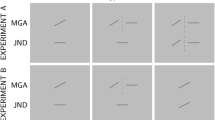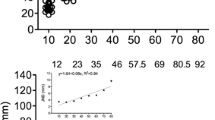Abstract
Recent work proposed that biomechanical constraints in aperture separation limit the utility of Weber’s law in determining whether dissociable visual codes support grasping and manual estimation. We tested this assertion by having participants precision grasp, manually estimate and complete a method of adjustment task to targets scaled within and beyond the range of their maximal aperture separation (i.e., from 20 to 140% of participant-specific maximal aperture separation: MAS). For grasping and manual estimation tasks, just-noticeable-difference (JND) scores were computed via the within-participant standard deviations in peak grip aperture, whereas method of adjustment JNDs were computed via the within-participant standard deviations in response output. Method of adjustment JNDs increased linearly across the range of targets; that is, responses adhered to Weber’s law. Manual estimation JNDs linearly increased for targets 20–100% of MAS and then decreased for targets 120–140% of MAS. In turn, grasping JNDs for targets 20% through 80% of MAS did not differ and were larger than targets 100–140% of MAS. That manual estimation and grasping showed a decrease in JNDs for the largest targets indicates that participants were at their biomechanical limits in aperture shaping, and the fact that the target showing the JND decrease differed between tasks (i.e., manual estimation = 100% of MAS; grasping = 80% of MAS) is attributed to the fact that grasping—but not manual estimation—requires a safety-margin task-set. Accordingly, manual estimations and grasping across a range of functionally ‘graspable’ targets, respectively, adhered to and violated Weber’s law—a result interpreted to reflect the use of dissociable visual codes.





Similar content being viewed by others
Notes
The sample size used here was based on a previous study by our group (Holmes et al. 2011) showing that grasping JNDs did not reliably vary with target size, F(4,52) = 0.54, p = 0.70, ηp2 = 0.10—a finding indicating that the absence of reliable effect was not related to an inadequate replication sample size (Keppel 1991). In turn, Holmes et al. showed that manual estimations (for every participant) demonstrated linear JND/target size relations, F(4,52) = 9.61, p < 0.001, ηp2 = 0.78.
In an original iteration of this experiment, the duration of data capture for trials in grasping and manual estimation tasks was 1.5 s. Notably, however, the time required to complete the manual estimation task (i.e., lift hand from home position and separate thumb and forefinger to match target size) sometimes exceeded the 1.5 s interval. As a result, for some trials participants were in the process of completing their manual estimation before the end of the data collection window. Thus, we collected a second set of manual estimation trials with a data capture length of 4 s and those data represent that reported in the manuscript. The second set of manual estimation trials (i.e., the data presented here) involved the same participants and was completed 10–12 weeks following the original collection period.
Bruno et al. (2016) do not provide measures of movement time or the timing of peak grip aperture.
References
Baird JC, Noma EJ (1978) Fundamentals of scaling and psychophysics. Wiley, New York
Brainard DH (1997) The psychophysics toolbox. Spat Vis 10:433–436
Bruno N, Uccelli S, Viviani E, de’Sperati C (2016) Both vision-for-perception and vision-for-action follow weber’s law at small object sizes, but violate it at larger sizes. Neuropsychologia 91:327–334
Bryden MP (1977) Measuring handedness with questionnaires. Neuropsychologia 15:617–624
Fitts PM (1954) The information capacity of the human motor system in controlling the amplitude of movement. J Exp Psychol 47:381–391
Franz VH (2003) Manual size estimation: a neuropsychological measure of perception? Exp Brain Res 151:471–477
Ganel T. Chajut E, Algom D (2008a) Visual coding for action violates fundamental psychophysical principles. Curr Biol 18:R599–R601
Ganel T, Chajut E, Tanzer M, Algom D (2008b) Response: when does grasping escape Weber’s law? Curr Biol 18:R1090–R1091
Ganel T, Namdar G, Mirsky A (2017) Bimanual grasping does not adhere to Weber's law. Sci Rep 7:6467
Gescheider GA (2013) Psychophysics: the fundamentals, 3rd edn. Lawrence Erlbaum, London
Goodale MA, Milner AD (1992) Separate visual pathways for perception and action. Trends Neurosci 15:20–25
Heath M, Manzone J, Khan M, Davarpanah Jazi S (2017) Vision for action and perception elicit dissociable adherence to weber’s law across a range of ‘graspable’ target objects. Exp Brain Res 235:3003–3012
Holmes SA, Heath M (2013) Goal-directed grasping: the dimensional properties of an object influence the nature of the visual information mediating aperture shaping. Brain Cogn 82:18–24
Holmes SA, Mulla A, Binsted G, Heath M (2011) Visually and memory-guided grasping: aperture shaping exhibits a time-dependent scaling to weber’s law. Vis Res 51:1941–1948
Jeannerod M (1984) The timing of natural prehension movements. J Mot Behav 16:235–254
Keppel G (1991) Design and analysis: a researcher’s handbook. Prentice Hall, Englewood Cliffs
Marks LE, Algom D (1998) Psychophysical scaling. In: Birnbaum MH (ed) Measurement, judgment, and decision making. Academic Press, San Diego, pp 81–178
Marteniuk RG, MacKenzie CL, Jeannerod M, Athenes S, Dugas C (1987) Constraints on human arm movement trajectories. Can J Psychol 41:365–378
Mckee SP, Welch L (1992) The precision of size constancy. Vis Res 32:1447–1460
Pedhazur EJ (1997) Multiple regression in behavioral research: explanation and prediction, 3rd edn. Harcourt Brace College Publishers, Orlando
Pheasant ST (1986) Bodyspace: anthropometric ergonomics and design. Taylor and Francis, London
Schmidt RA, Zelaznik H, Hawkins B, Frank JS, Quinn JT (1979) Motor-output variability: a theory for the accuracy of rapid motor acts. Psychol Rev 47:415–451
Smeets JB, Brenner E (1999) A new view on grasping. Mot Control 3:237–271
Smeets JB, Brenner E (2008) Grasping weber’s law. Curr Biol 18:R1089–R1090
Utz KS, Hesse C, Aschenneller N, Schenk T (2015) Biomechanical factors may explain why grasping violates weber’s law. Vis Res 111:22–30
Westwood DA, Chapman CD, Roy EA (2000) Pantomimed actions may be controlled by the ventral visual stream. Exp Brain Res 130:545–548
Acknowledgements
Supported by a Discovery Grant from the Natural Sciences and Engineering Research Council of Canada (MH) and Faculty Scholar and Major Academic Development Fund Awards from the University of Western Ontario.
Author information
Authors and Affiliations
Corresponding author
Ethics declarations
Conflict of interest
The authors declare no commercial, financial or other conflict of interest.
Rights and permissions
About this article
Cite this article
Ayala, N., Binsted, G. & Heath, M. Hand anthropometry and the limits of aperture separation determine the utility of Weber’s law in grasping and manual estimation. Exp Brain Res 236, 2439–2446 (2018). https://doi.org/10.1007/s00221-018-5311-6
Received:
Accepted:
Published:
Issue Date:
DOI: https://doi.org/10.1007/s00221-018-5311-6




